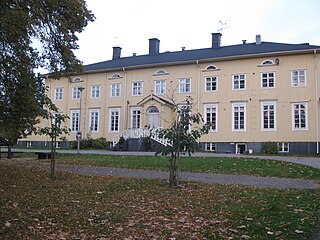
Hartola is a municipality of Finland. It is located in the Itä-Häme, Päijänne Tavastia region. The municipality has a population of 2,519 (31 August 2024), which make it the smallest municipality in Päijänne Tavastia in terms of population. It covers an area of 675.38 square kilometres (260.77 sq mi) of which 132.18 km2 (51.03 sq mi) is water. The population density is 4.64 inhabitants per square kilometre (12.0/sq mi). Neighbouring municipalities are Heinola, Joutsa, Luhanka, Pertunmaa and Sysmä.

Päijät-Häme is a region in Southern Finland south of the lake Päijänne. It borders the regions of Uusimaa, Kanta-Häme, Pirkanmaa, Central Finland, South Savo and Kymenlaakso. The biggest city in the region is Lahti.

Adolf Fredrik Church is a church in central Stockholm, Sweden, named after Adolf Frederick. It was built in 1768–1774, replacing a wooden chapel from 1674, which was dedicated to Saint Olof. It was inaugurated on 27 November 1774.

The Kerimäki Church in Kerimäki, Finland, is the largest wooden church in the world. However, it is not the tallest; Săpânța-Peri Monastery church in Romania, at 78 metres (256 ft), Ascension Cathedral in Kazakhstan, at 56 metres (184 ft) meters, and St. George's Cathedral in Guyana, at 43.5 metres (143 ft), are taller.

Pedersöre Church is a medieval stone church in Jakobstad. It is one of the oldest medieval churches in Ostrobothnia. The site of the first wooden church was built in the late 1200s. The church was re-built from its medieval design, and it was re-designed into a cross-church at the end of 1700s.

Lammi Church is a medieval stone church located in Lammi, Hämeenlinna, Southern Finland. It was built during the 1510s.

The Finlayson Church is a church built in Gothic Revival style located in the Finlayson industrial area in the district by the same name in Tampere, Finland. It was built in 1879 as the church of the Finlayson cotton factory, where the factory workers could practice religion. Currently the church belongs to the Evangelical-Lutheran congregations of Tampere, and it is used as a children's road church and a popular church for weddings.
Juutila Foundry is the oldest working bell foundry in Finland. Juutila foundry was founded in 1881.
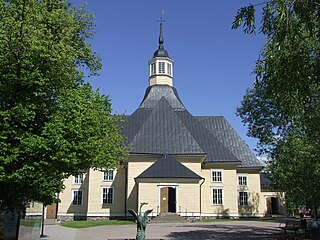
St. Mary's Church of Lappee is a wooden Evangelical Lutheran church in the center of Lappeenranta, Finland. The construction began in April 1792 and the church was consecrated partially unfinished in June 1794. The adjacent bell tower was built half a century later in 1856.

Gustav Adolf Church is a church in Habo Municipality in Sweden. Belonging to the Gustav Adolf Parish of the Church of Sweden, it was moved from Fiskebäck in 1780. On 19 November 1780, the church was inaugurated at its new location.
Gustav Adolf Church may refer to:
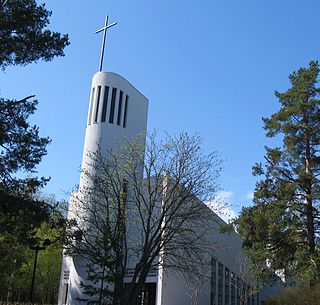
Kannonkoski Church is a Lutheran church in Kannonkoski, Finland. The church was designed by Pauli E. Blomstedt and represents Functionalism architecturally. The church was built in 1937–1938. Blomstedt never saw his church finished: he died in 1935 and the church was finished according to instructions by his wife, architect Märta Blomstedt, and architect Matti Lampén.

The Church of St. Lawrence is a church in Lohja, Finland. It is the third largest medieval parish church in Finland. The murals from early 16th century make it one of the most valuable medieval buildings in Finland. The rustic and naive murals depicted biblical stories for the illiterate population.
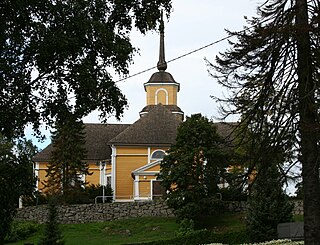
Nurmijärvi Church is a wooden church in Nurmijärvi, built in 1793. The church was built by Matti Åkerblom. The bell tower was completed in 1795 and was built by Mats Åkergren. The church is the fourth wooden church built in the Nurmijärvi village, the previous church built in 1692 was demolished in 1793.

Klaukkala Church is a copper-plated modern church in Klaukkala of the Nurmijärvi municipality, built in 2004. The church was designed by Anssi Lassila; interior furniture and lamps were designed by interior architect Antti Paatero and liturgical textiles by Hanna Korvela. Mikko Heikka, a bishop of the Evangelic Lutheran Church, dedicated it on November 28, 2004. Construction claimed one death when a worker fell from the roof.
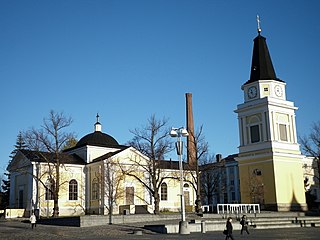
The Tampere Old Church is a wooden cross church opened in 1825 in Tampere, Finland near the Central Square. The old church is mainly used by the Swedish-speaking Lutheran congregation in Tampere. The church was designed by Italian-born Carlo Bassi and completed in 1824. The belfry, designed by C. L. Engel, was completed in 1828. The Old Church is the oldest surviving building in the city center of Tampere, and the adjoining belfry is the second oldest.
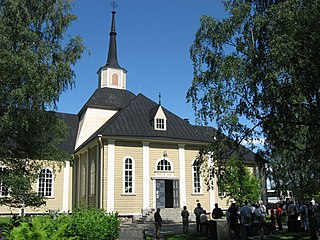
Gustav Adolf Church, also known as Iisalmi Old Church, is a wooden church in Iisalmi, Finland, which was consecrated in 1780. The Finnish Heritage Agency has classified the church as a nationally significant built cultural environment. Prior to the union of municipalities and parishes in the early 1970s, the Gustav Adolf Church was the main church of the Iisalmi rural parish, while the town parish used a new church completed in 1934. The church was to be named after the then Swedish heir to the crown, Gustav Adolf, and the use of the name was approved by the ruler later in the autumn.
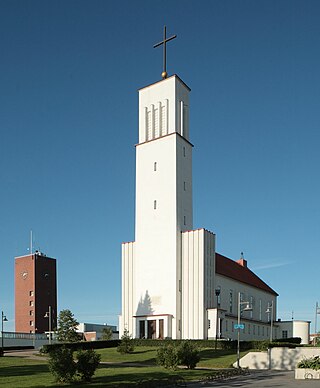
Holy Cross Church, also known as Iisalmi New Church, is a stone church in Iisalmi, Finland, which was consecrated in 1934. The church, designed by Eino Pitkänen, is a basilica with an end tower. The church, built of brick and concrete, represents a modernity based on classicism, which already resembles functionalism with its light wall surfaces. Before the association of municipalities and parishes in the North Savonian region in 1970, the Holy Cross Church was the main church of the Iisalmi Town Parish.

Pertunmaa Church is a short-towered wooden church in Pertunmaa, Finland, built according to the drawings of master builder Matti Vihonen in 1929. The church covers an area of 400 square meters and has seating for 400 people. The church was built partly from the logs of the old church of Hartola and in the same shape. The tower is built from the belfry of Hartola Church, but in a different shape. It has three floors and a lantern with a tent roof at the top. The two bells of the church were obtained from the former Russian military church in Mikkeli in 1924. The church has rounded windows at the ends and pilasters at the corners of the building, the outer ceilings have saddle ceilings. The interior is a wooden arch, the inner walls are on a log surface. The church was renovated in 1958. The altarpiece valled "Jesus blessing the children" was painted by Albert Carlsson.

Ekenäs Church is a 17th-century neoclassical stone church located in Ekenäs in the Finnish town of Raseborg. Construction began in 1651 and continued into the 1670s. The initiative to build a stone church in Ekenäs came from earl Gustaf Adolf Leijonhufvud but the designer of the original Baroque church is unknown.



















